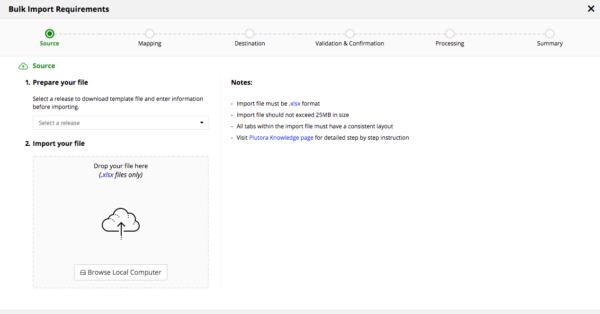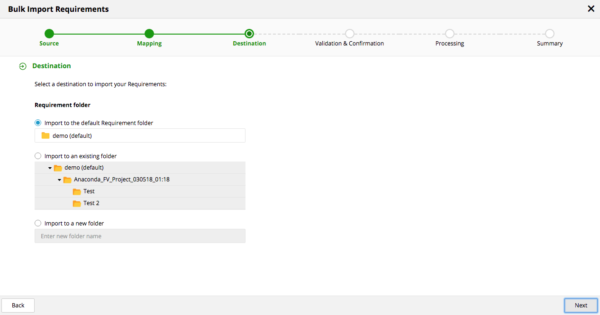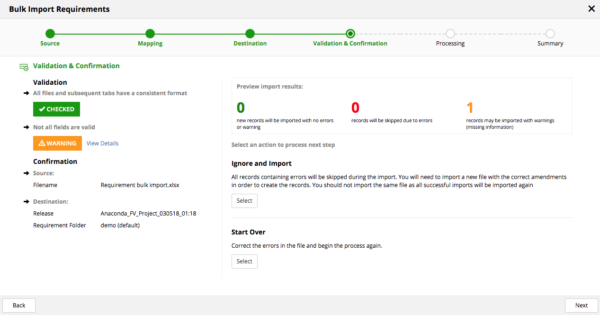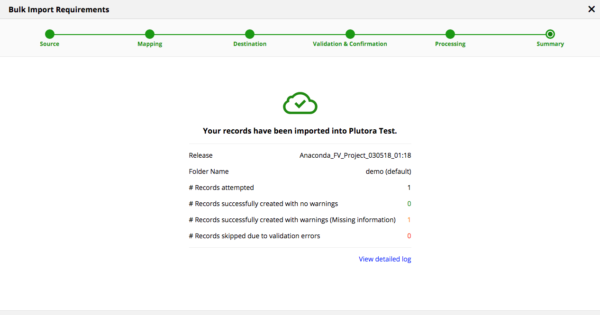1. Source tab
1a. Download the Excel import template file
Download the import template so you can start adding the data to be imported.
To download the import template:
- Click Requirements.

- Click Bulk Import.

NOT Bulk Update. - Select a Release to download an Excel template file.

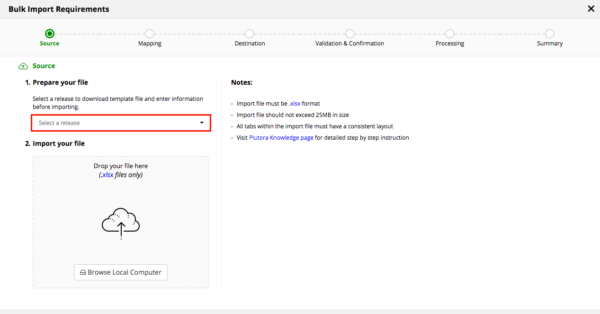
The template will contain a column for every field, including custom fields.
1b. Prepare the Excel template file
Add your Requirement data to the Excel template file.
To prepare your Excel files:
- Use the correct formats:
- Supported date formats are:
- DD/MM/YYYY (22/03/2019)
- DD/M/YYYY (22/3/2019)
- D/M/YYYY (9/03/2019)
- MM/DD/YYYY (03/22/2019)
- M/DD/YYYY (3/22/2019)
- M/D/YYYY (03/9/2019)
- YYYY/MM/DD (2019/03/09)
- Supported date and time formats are:
- DD/MM/YYYY HH:MM AM or PM (22/03/2019 09:00 PM)
- DD/MM/YYYY HH:MM (22/03/2019 21:00)
- MM/DD/YYYY HH:MM AM or PM (03/22/2019 09:00 PM)
- MM/DD/YYYY HH:MM (03/22/2019 21:00)
If seconds are present, they will be truncated.
- Supported time formats are:
- HH:MM AM or PM (09:00 PM)
- HH:MM (21:00)
If seconds are present, they will be truncated.
- Supported date formats are:
- Fill in mandatory core fields.
- Fill in mandatory custom fields.
Requirement records with bad formatting, missing data, or other errors will be handled by:
- Mandatory core and custom fields: Being skipped at import and an error being logged.
- Non-mandatory custom fields: Being imported without that data and a warning being logged.
1c. Upload the Excel file
To upload your Excel files to Plutora:
2. Mapping tab
Once your Excel file has uploaded, you must map each column of your data to a field in Plutora.
2a. Which mapping method should I use?
Auto Mapping
Auto Mapping saves time by automatically matching column headings with Plutora’s field names.
The Excel template file should map perfectly if the column headings are unedited and no Custom Fields have been added since the template was downloaded.
Manual Mapping
Manually map your data when:
- You only want to import mandatory fields, not custom fields.
- Your Excel file column heading cells do not match Plutora’s fields.
2b. Map data
To map your data:
- Select a Release.
- To select:
- Auto Mapping:
- Click Auto Mapping.
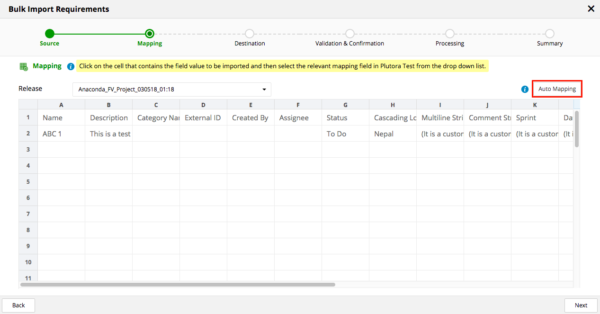
- All columns should highlight to show that they have been mapped.

- A warning pop up will show if any required or non-required field has not been mapped:
- The import will not proceed if any required fields have not been mapped.
- Close the pop up, then click Back, and upload an edited Excel file.
- Remove Auto Mapping by clicking Clear Mappings.
- All columns should highlight to show that they have been mapped.
- Click Next.
- Click Auto Mapping.
- Manual Mapping:
- Click a cell.
A map value pop up opens with the column value. For example, Column G.
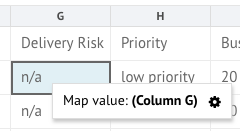
- Click the map value pop up.
The Copy Values pop up opens.
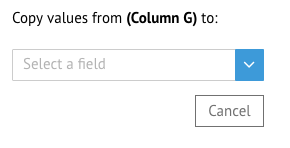
- Click the Select a field drop-down menu and select a field name where the column data should be copied.
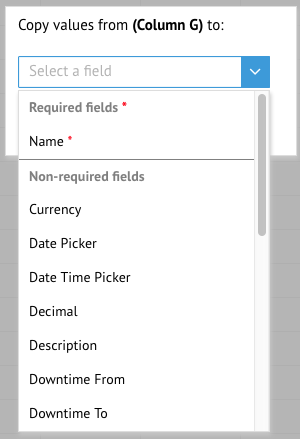
- Continue matching columns to fields until all mandatory fields and as many other values as necessary are mapped.
- To remove manual mappings, click Clear Mappings.
- When you have finished manual mapping, click Next.
- Click a cell.
- Auto Mapping:
3. Destination tab
After clicking Next, the Destination tab will open.
To select a destination for your Requirements:
- Select one of the following:
- Import to the default Requirement folder: The default option. Imports to the main Requirement folder.
- Import to an existing folder: Click to select the radio button and then click to select the folder.
- Import to a new folder: Type the folder name.
- Click Next.
4. Validation & Confirmation tab
After clicking Next, the Validation & Confirmation tab will open and the data will be validated.
Then the Validation & Confirmation message will open.
Click View Details under the Validation & Confirmation panel to see more information about the import:
- Errors (such as incorrect formatting) in mandatory fields will result in the record being skipped.
- Errors in non-mandatory fields will result in the record being imported with warnings.
Under the Confirmation panel, the numbers may not add up to the total number of records, as the same record can be skipped and have warnings at the same time.
Click Next to import the Excel file.
5. Processing tab
The file import processes, showing the percentage completed.
6. Summary tab
The Summary tab opens with an overview of the data imported and the error messages.
Click View detailed log to see the full list of records successfully created without warnings, the records created with a warning (for example, a missing value for a non-mandatory field), and records skipped and not created due to errors.
You have now bulk imported the data in your Excel file. Click the X on the top-right corner to close.

